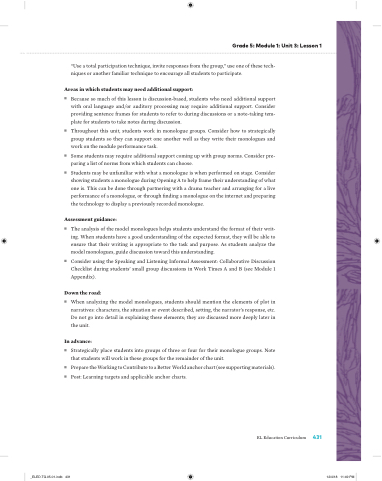Page 455 - EL Grade 5 Teacher Guide
P. 455
Grade 5: Module 1: Unit 3: Lesson 1
“Use a total participation technique, invite responses from the group,” use one of these tech- niques or another familiar technique to encourage all students to participate.
Areas in which students may need additional support:
■ Because so much of this lesson is discussion-based, students who need additional support with oral language and/or auditory processing may require additional support. Consider providing sentence frames for students to refer to during discussions or a note-taking tem- plate for students to take notes during discussion.
■ Throughout this unit, students work in monologue groups. Consider how to strategically group students so they can support one another well as they write their monologues and work on the module performance task.
■ Some students may require additional support coming up with group norms. Consider pre- paring a list of norms from which students can choose.
■ Students may be unfamiliar with what a monologue is when performed on stage. Consider showing students a monologue during Opening A to help frame their understanding of what one is. This can be done through partnering with a drama teacher and arranging for a live performance of a monologue, or through nding a monologue on the internet and preparing the technology to display a previously recorded monologue.
Assessment guidance:
■ The analysis of the model monologues helps students understand the format of their writ- ing. When students have a good understanding of the expected format, they will be able to ensure that their writing is appropriate to the task and purpose. As students analyze the model monologues, guide discussion toward this understanding.
■ Consider using the Speaking and Listening Informal Assessment: Collaborative Discussion Checklist during students’ small group discussions in Work Times A and B (see Module 1 Appendix).
Down the road:
■ When analyzing the model monologues, students should mention the elements of plot in narratives: characters, the situation or event described, setting, the narrator’s response, etc. Do not go into detail in explaining these elements; they are discussed more deeply later in the unit.
In advance:
■ Strategically place students into groups of three or four for their monologue groups. Note that students will work in these groups for the remainder of the unit.
■ Prepare the Working to Contribute to a Better World anchor chart (see supporting materials).
■ Post: Learning targets and applicable anchor charts.
EL Education Curriculum 431
_ELED.TG.05.01.indb 431
12/4/18 11:49 PM


